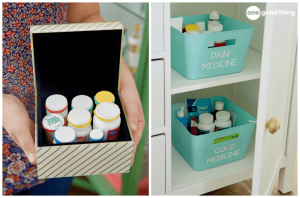I’ve come to realize that “medicine cabinet” is a bit of a misnomer. The first reason is because until recently, my medicine cabinet was home to not only medicine, but also vitamins, creams, cosmetics, bandaids, hair accessories, a dozen half-used tubes of chapstick, and who knows what else! And secondly, because it turns out that the medicine cabinet isn’t actually a great place to store your medication in the first place!
In today’s post, I’ll tell you why you may want to move your meds out of the medicine cabinet, and where you should store them instead. I’ll also share some other helpful tips about safely storing, using, and disposing of medications. Medication safety is so important, and following these simple tips could help prevent an unfortunate accident or incident from occurring under your roof.
The Best Place To Store Your Medication
It turns out that storing your meds in your medicine cabinet may not be the best option! It’s easy to forget about your medications when they’re stashed away behind that cabinet door, making it much more likely that you’ll forget about taking them. And more often than not, your medicine cabinet is in the bathroom, which tends to stay warmer and more humid than the other rooms in your house. Neither of these conditions is good for storing medications!
I recommend pulling your meds out of your medicine cabinet, and storing them in a decorative box instead. It’s easy to store a box safely out of reach, while still having it act as a visual reminder to take your meds. (Of course, that means storing the box somewhere you know you’ll see it every day!)
More Helpful Tips For Storing Medication
- Keep Them Cool & Dry
The optimal storage conditions for medications are somewhere cool, dry, and dark. The box itself will keep light away from your meds, so all you have to do is make sure that you store the box somewhere cool and dry. This could be up on a shelf somewhere, or in a drawer that you use frequently.
- Use A Lock
It’s important to take special precautions when storing certain medications, like those that treat anxiety, depression, or pain. These medications can be habit forming, and potentially harmful to those who haven’t been prescribed them. Consider storing these types of medications in a box or bag with a lock and key, or in a drawer that locks. It’s better to be safe than sorry!
- Color Code Them
Especially when you’re storing your meds in a box, you may want a quicker way to tell which medication bottle is which. You can put colored stickers on the lids, or wrap colored rubber bands around the lids to identify them. Each color could stand for a different type of medication (for instance, red might mean heart medications, while green is for allergy relief.) You could also use a different color for each member of the family, or the colors could signify how often you take that medication. You can use any color coding system that works for you!
- Take An Inventory
When you’re clearing all of your medications out of your medicine cabinet, take a moment to clear out anything you don’t need. For each medication you keep, you should know who prescribed it, who it was prescribed for, why it was prescribed, and when it will expire.
- Dispose Safely
If a medication is past its expiration date, or is no longer needed, it’s time to dispose of it. Some Walgreen’s locations accept medications for proper disposal. You can also search for controlled substance disposal locations through the DEA at this link.
If there are no safe disposal locations near you, here are some tips for doing it at home. Pour the medication from the bottle into a sealable bag, along with a handful of something unappetizing, like dirt, kitty litter, or used coffee grounds. Dispose of the bag in your trash. Dispose of the medication bottle separately, after blocking out any personal information with a dark marker.
- Stay Organized On The Go
When you’re traveling or simply out running errands, use a pill organizer to keep your medications handy and stored properly.

